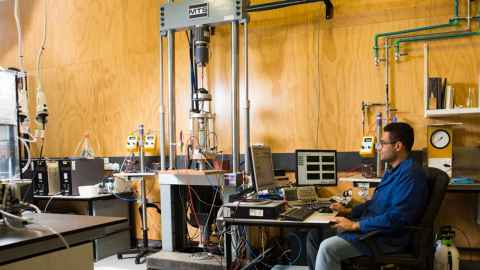Geotechnical Engineering
We focus on the interface between the built and natural environments, and collaborate with international research groups across the United States, Japan, Europe and more.

*New applicants/students interested in this specialisation should apply for the Master of Civil Engineering
Geotechnical engineering covers all aspects of civil engineering at the interface between the built and natural environments, including the design of foundations for buildings and bridges, design and construction of earth dams, tunnelling, and the impact of natural hazards associated with earthquakes on the built environment.
In the New Zealand environment, the solution of slope stability problems is also an important part of the work of the geotechnical profession. Several of current research interests are related to these problems.
Our research
Some current research areas include:
- Laboratory and field characterisation of the geotechnical properties of New Zealand materials, including the properties of sands containing pumice and the compressibility of Auckland soils
- Seismic response of soil structures, including soil liquefaction and ground remediation through laboratory testing and numerical simulations
- The design of foundations to resist earthquake loads and particularly the integrated design of structure-foundation systems
- Estimating the shear strength properties of the closely jointed greywacke rock that forms the steep slopes in the Wellington area
- Geotechnical properties and performances of blended aggregate with waste and recycled materials in pavement applications
- Micro-mechanical behaviour of geo-materials and its effect on macro-response
- Rainfall-induced slope instabilities and shrink-swell characteristics
- Engineering seismology and dynamic site response
The Geotechnical Engineering Laboratory
The Geotechnical Engineering Laboratory is a modern research facility housing a range of equipment for evaluating soil and rock properties.
The laboratory has the following equipment and capabilities:
- 250 kN servo hydraulic load frame used for static and cyclic testing
- Cyclic simple shear apparatus
- Triaxial apparatus
- Oedometers
- Annular ring shear apparatus
- Direct shear apparatus
- Ko tri-axial cells
- Bender element system
- Soil suction testing and evaluation of the thermal response of soils
- Equipment for preparing and testing rock specimens
- Equipment for soil classification testing and determination of index properties
The following field testing capabilities are also available:
- Dynamic testing of foundations using hydraulic rams and quick release connections
- Screw Driving sounding (SDS) machine
- Surface wave field testing equipment (Spectral Analysis of Surface Waves (SASW), Multi-channel Analysis of Surface Waves (MASW)
- Acoustic emissions equipment
A number of geotechnical numerical analysis software (FLAC 2D/3D, PLAXIS 2D/3D, OpenSees, FLIP and the GeoStudio Suite) is utilised. Scanning electron microscopes and micro CT scanning equipment are additionally available in the Faculty of Engineering.